Gasch R., Twele J. (Eds.) Wind Power Plants: Fundamentals, Design, Construction and Operation
Подождите немного. Документ загружается.

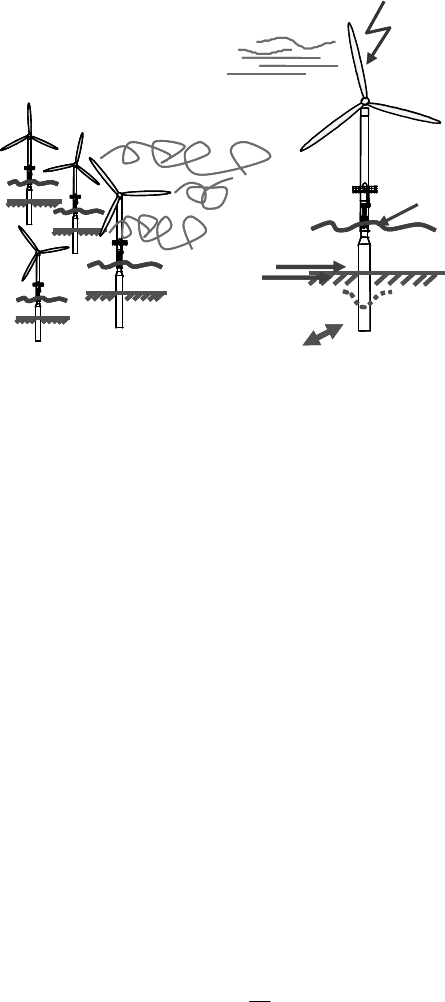
522 16.1 Offshore environment
ambient turbulence
wake turbulence
ship impact
(breaking) ice
marine growth
salinity, humidity
& temperature
currents tides
(breaking) waves
earthquake
operational
& accidental loads
icing
scour
foundation
behaviour
lightning
grid interaction
ambient turbulence
wake turbulence
ship impact
(breaking) ice
marine growth
salinity, humidity
& temperature
currents tides
(breaking) waves
earthquake
operational
& accidental loads
icing
scour
foundation
behaviour
lightning
grid interaction
Fig. 16-3 Environmental impact on an offshore wind farm
Perhaps the most important consequence of the harsh offshore environment is the
high design requirements. Turbines must be able to function unmanned over a
long repayment period (up to 20 years) at a remote location that is difficult for
maintenance personnel to access.
Using an example, we illustrate some fundamentals of wind-induced wave
loading. Generally, one has to distinguish between sea conditions generated by
local winds and swells originating from waves that have travelled a long distance.
The topography of the North Sea and the Baltic Sea, for instance, leads to less sig-
nificant swells.
The periods of energy-rich waves range between 2 s and 20 s. The energy of a
sea state is proportional to the square of the significant wave height which itself is
proportional to at least the second power of the zero-crossing period. Extreme
waves have long periods, typically 7 to 13 s. Nonetheless, waves of moderate
height are most important for dynamic wave loading and associated fatigue since
their occurrence is high - 1 to 5 million waves per annum - and their periods are
closer to the fundamental natural period of the structure.
The water surface profile of a wind-sea is random. For design calculations,
such a sea state is decomposed into many elementary, regular waves. When con-
sidering extreme loading, one dominant, regular wave is often isolated. Assuming
a wave height H, which is small compared to the water depth d, the linear, Airy-
wave theory describes the water surface profile Ș as a sinusoidal function of the
circular wave frequency Ȧ and time t (Fig. 16-4).
)cos(
2
)( t
H
t
ZK
(16.1)
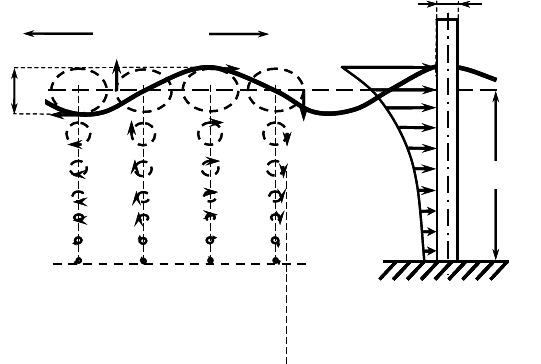
16 Offshore wind farms 523
Depth d
Wave length L
H
Pile diameter D
Wave
hight
Depth d
Wave length L
H
Pile diameter D
Wave
hight
Fig. 16-4 Surface profile and water particle velocities of a small amplitude wave and wave
forces on a slender vertical pile
T/2
Lk /2
(16.2)
The propagation of the wave profile results from the motion of the water particles
in stationary, elliptical orbits. The extension of the paths, and the associated parti-
cle velocities, accelerations and forces, decay exponentially with depth (Fig.
16-4).
Waves approaching the shore become steeper as wave height increases and
wave length decreases. The wave 'feels' the sea bottom and breaks when the height
is equal to 78% of the water depth under ideal conditions. The transcendental dis-
persion equation expresses the relation between wave length or, more precisely,
the wave number k and the wave frequency ω for a certain water depth d. To find
the wave number, an iterative process may be started using the deep water case,
k = ω
2
/ g , where g equals the gravity acceleration.
)(tan
2
dkhkg
(16.3)
Wave loading consists of:
Drag loading, caused by vortices generated in the flow as it passes the struc-
ture. The associated forces are proportional to the square of the relative particle
velocity both in steady currents and in waves.
It is more convenient to use the circular wave frequency ω instead of the wave
T. Analogously, the so-called “wave number” k is defined in respect to the
wave length L.
period

524 16.1 Offshore environment
x Inertia loading, generated by the pressure gradient in an accelerating fluid mov-
ing around a member. The inertia force is proportional to the acceleration of the
water particles.
x Diffraction loading, a part of the inertia force on a structure which is so large
that the wave kinematics are altered significantly by its presence, i.e. when the
diameter of the member D is larger than one fifth of the wave length L.
x Water added mass, an inertia force experienced by a member accelerated rela-
tive to the fluid.
x Slam and slap loading, an inertia force proportional to the square of the relative
velocity when a member passes through the water surface e.g. resulting from
the impact of a breaking wave.
In most cases, diffraction is not significant and the Morison wave force equa-
tion with the empirical drag and inertia coefficient C
D
| 0.7 and C
M
| 2.0 can be
applied [4]. For a cylindrical, vertical pile with diameter D the amplitudes of the
drag and inertia wave force can be integrated analytically over the water depth.
1)2(cosh
2)2(sinh
16
ˆ
22
dk
dkdk
k
HDC
F
D
D
ZU
(16.4)
k
HDC
F
M
M
8
ˆ
22
ZUS
(16.5)
Here
U
denotes the water density. The drag force varies with a cos
2
-function while
the inertia force has a sinusoidal relation on time. The maximum of the total hori-
zontal wave force can be found by numerically evaluating the quarter of the wave
period in which both components reach their extremes.
^
`
tFttFF
MD
t
T
ZZZ
dd
sin
ˆ
coscos
ˆ
max
ˆ
0
4
(16.6)
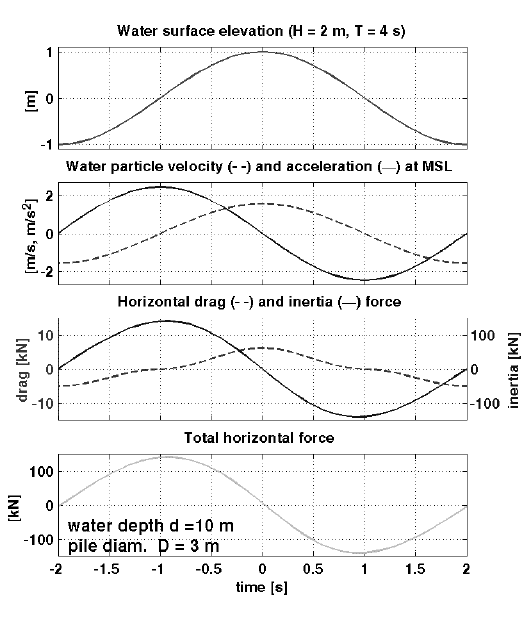
16 Offshore wind farms 525
Fig. 16-5 Kinematics and forces of an inertia dominated fatigue wave calculated with linear
wave theory
The particle kinematics and associated forces for two waves are shown in relation
to a monopile with a 3 m diameter and in a water depth of 10 m. For a typical
fatigue wave with a height of 2 m, the inertia force dominates and the behaviour is
linear (Fig. 16-5).
In contrast, both the water kinematics and the loading become non-linear in ex-
treme conditions. Fig. 16.6 shows the kinematics and loads associated with a wave
of 6.4 m height computed with a non-linear wave theory. The wave crest of 4.95
m is more than three times higher than the trough. This relation yields high parti-
cle velocities in the crest and a drag force that is almost the same magnitude as the
inertia force. The maximum horizontal wave force has a lever arm approx. equal
to the water depth and the resulting overturning moment at the seabed contains
several higher harmonics with significant excitation energy.
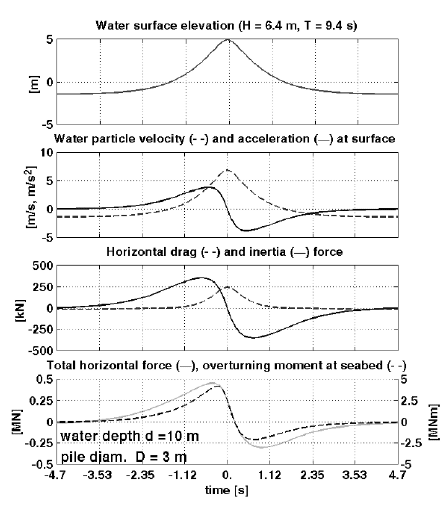
526 16.2 Offshore design requirements
Fig. 16-6 Kinematics and forces of an extreme wave in shallow water calculated with the non-
linear, 10th order stream function wave theory
16.2 Offshore design requirements
What are the design drivers for offshore wind turbines? It is often argued that the
economic viability of offshore projects will depend on the use of very large (i.e.
5 MW or larger) turbines. This certainly holds for exposed sites with water depths
above 25 m and a large distance to shore which is both typical for German off-
shore sites. Easily, the reduction of the weight of the wind turbine, which
increases disproportionately with R
2,5
to R
3
(see Table 7.1), has the most influence
on the dimension of the structure. Therefore, the use of new control concepts, in-
novative drive train designs and innovative materials is often required. High infra-
structure costs, e.g. for the high-voltage grid connection, result in a minimum
profitable project size of about 100 MW and larger.
First of all, the high-quality requirements for offshore wind turbines have to be
met before large projects with large wind turbines can become viable. Therefore,
offshore-specific design requirements are often integrated into conventional wind
16 Offshore wind farms 527
turbine concepts. Such an approach would emphasise a reduction in operation and
maintenance (O&M) costs, overall risk control, and the balance of investment
costs over the entire wind farm.
Four qualitative rather than quantitative offshore design requirements can be
formulated:
- Integrated design of offshore wind farms
A more cost-efficient and reliable design can be achieved through an inte-
grated design approach that considers the entire offshore wind farm as one
system (Fig. 16-2). The optimum offshore design will differ from land-
based designs since the investment will be differently distributed among
the sub-systems and since O&M costs will be higher. Dynamics and sup-
port structure design should be adjusted according to the particular site
conditions and the turbine design.
- Design for RAMS (Reliability, Availability, Maintainability & Serviceabil-
ity)
Operation and maintenance aspects are a main design driver for offshore
wind farms. Remote locations and poor weather conditions can postpone
maintenance and result in longer downtime and greater losses of produc-
tion. Therefore, the standard for offshore turbine reliability must be even
higher than the already rigorous standards for land-based turbines. A
commitment to reliability, in conjunction with dedicated machine design,
comprehensive O&M strategies and specific maintenance hardware results
in acceptable availability and reasonable operating costs.
- Smooth grid integration and controllability
Future large-scale offshore wind farms will be operated as power plants,
and will be a part of national, and possibly international, energy systems.
Offshore wind farms must therefore be smoothly integrated into the grid
and turbines must be controllable under normal operation and in case of
grid disturbances. When combined with other considerations such as dy-
namic loading, these requirements rule out traditional stall control systems
in favour of variable-speed, variable-pitch designs.
- Optimised logistics and offshore installation
Sea-based wind farms afford the opportunity for considerable logistical
optimisation despite high cost. Manufacturing, transport and installation
can all be optimised when the number of heavy components to be lifted is
reduced and pre-commissioning can be done in the harbour.
528 16.3 Wind turbines
16.3 Wind turbines
It is clear that the offshore environment places demands on wind turbines that are
not present in an onshore context. It is also evident, however, that offshore wind
turbines, above the height of the wave impact, are not very different from onshore
machines. Two technical approaches have been taken in developing offshore wind
turbines: the marinisation of robust and proven onshore solutions and the integra-
tion of offshore-specific concepts into radical new designs.
In the marinisation process, modifications are made to onshore designs when
they are transferred to offshore sites: maintenance aids that enable on-site repair of
some components are added, climate and corrosion protection for the nacelle is
improved, control capabilities are enhanced, and the specific rating, i.e. installed
capacity per swept rotor area, is partially increased. An air-tight nacelle is some-
times proposed but this obliges to employ external heat exchangers for the gear-
box, the generator and the power electronics. In addition, an air-tight nacelle re-
quires an expensive and energy-consuming cooling system for the other smaller
sources of radiated heat. For these reasons, most designs rely on a high standard of
corrosion protection and the capsulation of individual components instead of an
air-tight nacelle. The REpower 5M, which was first built in 2004, is an example
for a marinized turbine using a conventional design concept in the 5 MW class.
Again two different trends have emerged from the integration of offshore re-
quirements into the design process: a focus on reliability and serviceability and the
development of advanced lightweight, high-tip-speed designs. Another example of
new design concepts is the Multibrid M5000 turbine which was first installed in
2004 as well. The weight of the nacelle is reduced by using a highly integrated
drive train. Moreover, it features the avoidance of high-speed stages of the gear-
box by matching a one-and-a-half-stage planetary gear with an intermediate-speed
synchronous generator with permanent magnets (Fig. 3.13). So this drive train
concept is situated between the traditional Direct-Drive design (e.g. Enercon) and
the commonly used designs with a multi-stage gearbox with a high-speed genera-
tor. The nacelle of the Multibrid M5000 is enclosed against the maritime environ-
ment and cooled by heat exchangers.
The ongoing rapid growth in turbine size and the need to base production on
proven technology favours the horizontal axis, upwind-oriented turbine design that
is used in land-based solutions. Though all offshore turbines are currently three-
bladed designs, advanced two-bladed concepts might be applied at a later, matured
stage. Two-bladed turbines have several advantages over three-bladed designs.
First of all, two-bladed turbines are comparatively simple to install and maintain.
Also, relaxed noise limitations offshore enable the use of a higher rotor speed,
which reduces both the dimensioning torque for the drive train and the transmis-
sion ratio of the gearbox. Lower blade solidity is optimal for higher speeds and
this can be achieved by omitting the third blade. Despite these advantages, how-
ever, the complicated dynamic behaviour and the alternation of high loads are
16 Offshore wind farms 529
major challenges for two-bladed machines. Furthermore, the offshore market must
be large enough at the time of the marketability of the wind turbine in order to
make the development of a product purely designed for offshore conditions profit-
able.
16.4 Support structures and marine installation
The turbine support structures, i.e. the integrity of tower and marine foundation,
are the most obvious differences between offshore and land-based wind turbines.
Ferguson classifies offshore bottom-mounted support structures according to three
basic properties: structural configuration, foundation type and installation princi-
ple [5]. Any structural concept, including monotowers, braced towers and lattice
towers, can be reasonably combined with either a piled or a gravity foundation.
From a logistical point of view, however, it is beneficial to match piled designs
with lifted installation and gravity foundations with floated installation (Fig. 16-7).
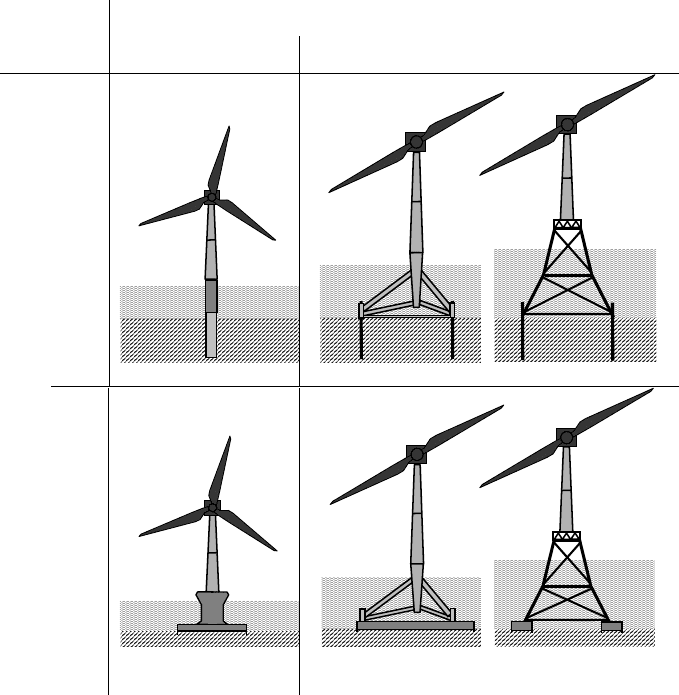
530 16.4 Support structures and marine installation
Configuration
Mono Tower Braced Tower / Lattice Tower
Piled & Lifted
Monopile
Piled tripod or lattice tower
Foundation & Installation
Gravity & Floated
`
Gravity base
mono tower
Gravity base tripod or
gravity base lattice tower
Fig. 16-7 Classification of bottom-mounted support structure types by structural configuration,
foundation and installation principle
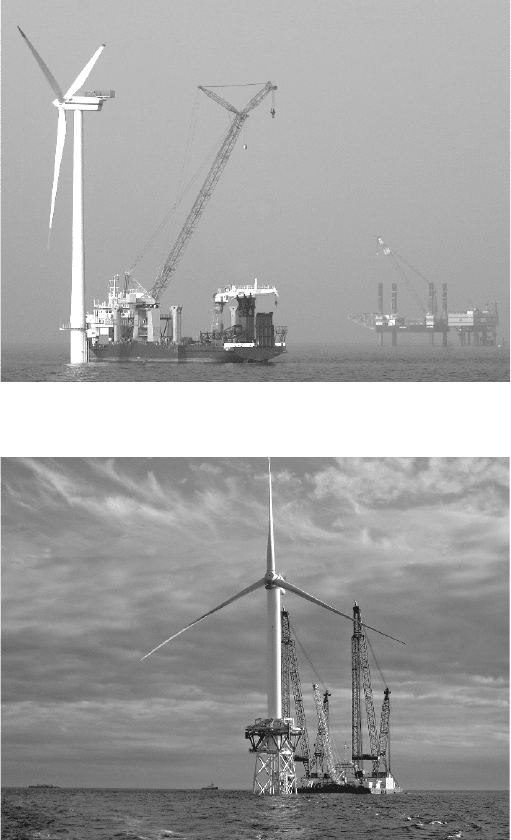
16 Offshore wind farms 531
Fig. 16-8 Installation of an offshore wind turbine on a jacket support structure in 45 m water
depth [REpower Systems AG]
Fig. 16-9 Rotor installation at the Utgrunden wind farm with two jack-up barges and two tug
boats [Photo Uffe Kongsted]
Driven or drilled, steel monopiles are currently the preferred solution. They are
economically attractive for use with the 2 to 3 MW class in water depths of
approx. 20 m, and for use with 5 MW designs in depths up to 15 m. For larger
depths, tripod, quadropod or lattice structures are needed. In 2006 the first jacket
foundations for offshore turbines have been installed in 45 m water depth in Scot-
land (Fig. 16-8). Gravity foundations have been applied mainly at shallow Danish
